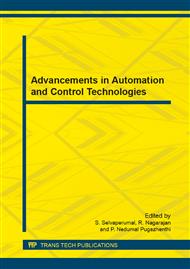[1]
Handbook of power quality 'john Wiley and sons ltd edited by Angelo Baggini, P. No. 521-522, (2008).
Google Scholar
[2]
New power-quality assessment criteria for supply systems under unbalanced and non sinusoidal conditions, Power Delivery, IEEE Transactions on Volume: 19 Issue: 3 P. No. 1284 – 1290.
DOI: 10.1109/tpwrd.2004.829928
Google Scholar
[3]
Bhim Singh, , and Vishal Verma, Selective Compensation of Power-Quality Problems through Active Power Filter by Current Decomposition IEEE transactions on power delivery, vol. 23, no. 2, April (2008).
DOI: 10.1109/tpwrd.2007.911108
Google Scholar
[4]
R. Rezaeipour and A. Kazemi, Review of novel control strategies for UPQC, Int. J Elect. Power Eng., vol. 2, p.241–247, (2008).
Google Scholar
[5]
F. Z. Peng, G. W. Ott, and D. J. Adams, Harmonic and reactive power compensation based on the generalized instantaneous reactive power theory for three-phase four-wire systems, IEEE Trans. Power Electron., vol. 13, no. 6, p.1174–1181, Nov. (1998).
DOI: 10.1109/63.728344
Google Scholar
[6]
H. Fujita and H. Akagi, The unified power quality conditioner: The integration of series and shunt-active filters, IEEE Trans. Power Electron., vol. 13, no. 2, p.315– 322, Mar. (1998).
DOI: 10.1109/63.662847
Google Scholar
[7]
H. Karimi, M. K. Ghartemani, M. R. Iravani, and A. R. Bakhshai, An adaptive filter for synchronous extraction of harmonics and distortions, IEEE Trans. Power Del., vol. 18, no. 4, p.1350–1356, Oct. (2003).
DOI: 10.1109/tpwrd.2003.817752
Google Scholar
[8]
N. G. Jayanti, M. Basu, M. F. Conlon, and K. Gaughan, Rating requirements of the unified power quality conditioner to integrate the fixed-speed induction generator-type wind generation to the grid, Inst. Eng. Technol. Renew. Power Gen., vol. 3, no. 2, p.133–143, (2009).
DOI: 10.1049/iet-rpg:20080009
Google Scholar
[9]
A. Teke, K. Ç. Bayindir, and M. Tümay, Fast sag/swell detection method for fuzzylogic based dynamic voltage restorer, Inst. Eng. Technol. Gen., Transm. Distrib., vol. 4, no. 1, p.1–12, (2009).
DOI: 10.1049/iet-gtd.2009.0423
Google Scholar
[10]
Y. Y. Kolhatkar and S. P. Das, Experimental investigation of a singlephase UPQC with minimumVA loading, IEEE Trans. Power Del., vol. 22, no. 1, p.373–380, Jan. (2007).
DOI: 10.1109/tpwrd.2006.881471
Google Scholar
[11]
M. Basu, S. P. Das, and G. K. Dubey, Investigation on the performance of UPQC-Q for voltage sag mitigation and power quality improvement at a critical load point, Inst. Eng. Technol. Gen. Transm. Distrib., vol. 2, p.414–423, (2008).
DOI: 10.1049/iet-gtd:20060317
Google Scholar
[12]
Power quality by C. Sankaran, published by CRC press, (2002).
Google Scholar
[13]
B. Renders, K. De Gusseme, W. R. Ryckaert, K. Stockman, L. Vandevelde, and M. H. J. Bollen, Distributed generation for mitigating voltage dips in low-voltage distribution grids, IEEE Trans. Power. Del., vol. 23, no. 3, p.1581–1588, Jul. (2008).
DOI: 10.1109/tpwrd.2007.916162
Google Scholar
[14]
Tarak Salmi, Mounir Bouzguenda, Adel Gastli, Ahmed Masmoudi, MATLAB/Simulink Based Modelling of Solar Photovoltaic Cell, international journal of renewable energy research, Vol. 2, No. 2, (2012).
DOI: 10.1109/revet.2012.6195248
Google Scholar
[15]
B. Renders, K. De Gusseme, W. R. Ryckaert, K. Stockman, L. Vandevelde, and M. H. J. Bollen, Distributed generation for mitigating voltage dips in low-voltage distribution grids, IEEE Trans. Power. Del., vol. 23, no. 3, p.1581–1588, Jul. (2008).
DOI: 10.1109/tpwrd.2007.916162
Google Scholar
[16]
FACTS controllers in power transmission and distribution by K.R. Padiyar, published by New age international (P)Ltd. (2007).
Google Scholar
[17]
Vadirajacharya G. Kinhal, Promod Agarwal, and Hari Oam Gupta, Performance Investigation of Neural-Network-Based Unified Power-Quality Conditioner, IEEE transactions on power delivery, vol. 26, no. 1, January (2011).
DOI: 10.1109/tpwrd.2010.2050706
Google Scholar


